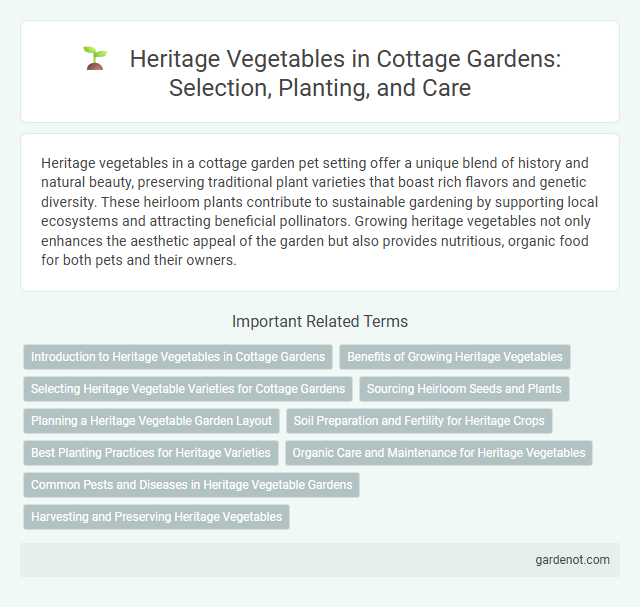Heritage vegetables in a cottage garden pet setting offer a unique blend of history and natural beauty, preserving traditional plant varieties that boast rich flavors and genetic diversity. These heirloom plants contribute to sustainable gardening by supporting local ecosystems and attracting beneficial pollinators. Growing heritage vegetables not only enhances the aesthetic appeal of the garden but also provides nutritious, organic food for both pets and their owners.
Introduction to Heritage Vegetables in Cottage Gardens
Heritage vegetables, also known as heirloom varieties, are traditional plant cultivars passed down through generations, valued for their unique flavors, colors, and historical significance in cottage gardens. These varieties thrive in small-scale, diverse garden settings, contributing to biodiversity and preserving agricultural heritage. Cultivating heritage vegetables in cottage gardens supports sustainable practices and offers a rich culinary experience rooted in history.
Benefits of Growing Heritage Vegetables
Growing heritage vegetables in a cottage garden preserves genetic diversity and supports the resilience of food systems by maintaining a wide range of plant varieties adapted to local conditions. These vegetables often possess superior taste, nutritional value, and unique flavors compared to commercial hybrids, enriching culinary experiences. Cultivating heritage varieties also promotes sustainable gardening practices by encouraging seed saving and reducing dependence on industrial agriculture.
Selecting Heritage Vegetable Varieties for Cottage Gardens
Choosing heritage vegetable varieties for cottage gardens ensures rich flavors and genetic diversity that modern hybrids often lack. Varieties like 'Brunswick Green' beans, 'Long Scarlet' radishes, and 'Black Krim' tomatoes offer resilience and adaptability to local climates. Selecting these time-tested cultivars enhances the garden's historical authenticity and promotes sustainable gardening practices.
Sourcing Heirloom Seeds and Plants
Heirloom seeds and plants form the cornerstone of a vibrant cottage garden, offering unique flavors and rich genetic diversity. Sourcing heirloom varieties from reputable seed banks and local heritage nurseries ensures preservation of rare cultivars and enhances garden authenticity. These plants thrive with traditional growing methods, connecting gardeners to historical agricultural practices while enriching biodiversity.
Planning a Heritage Vegetable Garden Layout
Designing a heritage vegetable garden layout involves selecting diverse heirloom varieties that reflect historical agricultural practices and local climate adaptability. Prioritize companion planting techniques to enhance growth and pest resistance, ensuring plants with complementary root depths and nutrient needs are grouped effectively. Incorporate pathways and raised beds to optimize space, drainage, and ease of maintenance while preserving the authentic aesthetic of a traditional cottage garden.
Soil Preparation and Fertility for Heritage Crops
Heritage vegetables thrive in rich, well-drained soil with high organic matter content to support their unique growth requirements. Incorporating compost, aged manure, and natural amendments like bone meal enhances nutrient availability and soil structure, promoting robust root development. Regular soil testing ensures balanced fertility, maintaining ideal pH levels between 6.0 and 7.0, essential for optimal nutrient uptake in heritage crops.
Best Planting Practices for Heritage Varieties
Heritage vegetable varieties thrive when planted in well-drained, nutrient-rich soil with pH levels between 6.0 and 7.0, promoting vigorous growth and flavor retention. Incorporating organic matter such as compost before planting enhances soil fertility and moisture retention, essential for these heirloom crops. Rotating crops annually and spacing plants adequately reduces disease risk and supports genetic diversity, ensuring sustainable yields.
Organic Care and Maintenance for Heritage Vegetables
Heritage vegetables thrive in cottage gardens when nurtured with organic care methods that promote soil health and biodiversity. Employing techniques such as crop rotation, natural mulching, and compost enrichment helps maintain nutrient-rich soil while preventing pests and diseases without synthetic chemicals. Consistent watering, alongside periodic pruning and hand-weeding, ensures robust growth and preserves the unique genetic traits of heirloom varieties.
Common Pests and Diseases in Heritage Vegetable Gardens
Heritage vegetable gardens often face common pests such as aphids, slugs, and cabbage moths that can significantly damage crop yields if not managed properly. Diseases like powdery mildew, blight, and clubroot frequently affect heritage varieties, requiring vigilant monitoring and organic control methods. Implementing crop rotation, companion planting, and natural predators helps maintain the health and productivity of heritage vegetable gardens.
Harvesting and Preserving Heritage Vegetables
Harvesting heritage vegetables requires careful timing to ensure peak flavor and nutritional value, often when fruits and pods are mature but still tender. Preserving methods like blanching and freezing, pickling, or drying retain the unique tastes and historical qualities of heirloom varieties for year-round enjoyment. Proper storage conditions, such as cool, dark, and humid environments, extend the shelf life of root vegetables and leafy greens while maintaining their heritage characteristics.
Heritage vegetable Infographic

 gardenot.com
gardenot.com